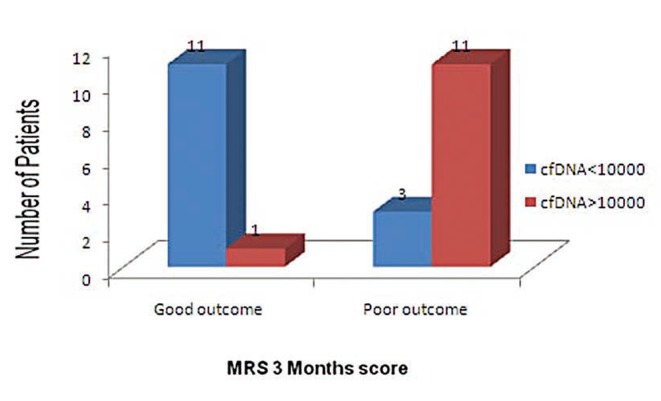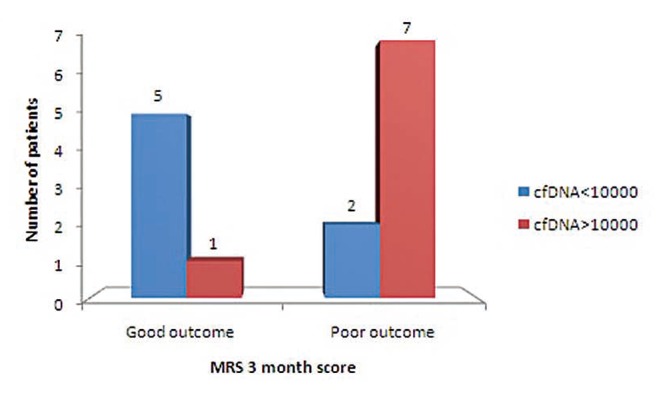Neurointervention.
2018 Mar;13(1):13-19. 10.5469/neuroint.2018.13.1.13.
Cell free DNA: A Novel Predictor of Neurological Outcome after Intravenous Thrombolysis and/or Mechanical Thrombectomy in Acute Ischemic Stroke Patients
- Affiliations
-
- 1Deparment of Neurology, Pacific Medical College & Hospital, Pacific Medical University, Udaipur, India. researchudr@gmail.com
- 2Deparment of Biochemistry, Pacific Medical College & Hospital, Pacific Medical University, Udaipur, India.
- KMID: 2424045
- DOI: http://doi.org/10.5469/neuroint.2018.13.1.13
Abstract
- PURPOSE
Several blood markers have been evaluated in stroke patients, but their role remains limited in clinical practice. This study was designed to evaluate the utility of cell free DNA (cf DNA) in stroke patients undergoing therapeutic intervention in the form of mechanical thrombectomy in acute ischemic stroke patients.
MATERIALS AND METHODS
Twenty-six patients with ischemic stroke who were managed with interventions like intravenous thrombolysis (IVT) and mechanical thrombectomy were recruited consecutively in this study. The cf DNA was extracted by using circulating nucleic acid kit and measured by real-time quantitative PCR assay for β-globin gene. The neurological outcome was measured by modified Rankin scale (mRS) score at three months after the onset of symptoms.
RESULTS
Cf DNA levels correlated with severity of stroke at the time of admission (r=0.421, P=0.032) and poor outcome at three months (r=0.606, P=0.001). Therapeutic intervention in the form of mechanical thrombectomy or IVT was associated with improved outcome in patients with cf DNA < 10,000 kilogenome-equivalents/L (P= < 0.05).
CONCLUSION
Cf DNA level correlated well with the 3 month outcome in acute ischemic stroke patients. It can be a potential supplementary marker to predict neurological outcome after therapeutic intervention.
Figure
Reference
-
1. The World Health Report: 2002: Reducing risks promoting healthy life. World Health Organization (WHO);2002.
Article2. Jickling GC, Sharp FR. Blood Biomarkers of Ischemic Stroke. Neurotherapeutics. 2011; 8:349–360. PMID: 21671123.3. Lo YM, Tein MSC, Lau TK, Haines CJ, Leung TN, Poon PM, et al. Quantitative analysis of fetal DNA in maternal plasma and serum: implications for noninvasive prenatal diagnosis. Am J Hum Genet. 1998; 62:768–775. PMID: 9529358.
Article4. Lo YM, Rainer TH, Chan LY, Hjelm NM, Cocks RA. Plasma DNA as a prognostic marker in trauma patients. Clin Chem. 2000; 46:319–323. PMID: 10702517.5. Bang OY, Goyal M, Liebeskind DS. Collateral Circulation in Ischemic Stroke: Assessment Tools and Therapeutic Strategies. Stroke. 2015; 46:3302–3309. PMID: 26451027.6. Adams HP Jr, Davis PH, Leira EC, Chang KC, Bendixen BH, Clarke WR, et al. Baseline NIH Stroke Scale score strongly predicts outcome after stroke: A report of the Trial of Org 10172 in Acute Stroke Treatment (TOAST). Neurology. 1999; 53:126–131. PMID: 10408548.
Article7. Banks JL, Marotta CA. Outcomes validity and reliability of the modified Rankin scale: implications for stroke clinical trials: a literature review and synthesis. Stroke. 2007; 38:1091–1096. PMID: 17272767.
Article8. National Institute of Neurological Disorders and Stroke rt-PA Stroke Study Group. Tissue plasminogen activator for acute ischemic stroke. N Engl J Med. 1995; 333:1581–1587. PMID: 7477192.
Article9. Saver JL, Jahan R, Levy EI, Jovin TG, Baxter B, Nogueira RG, et al. Solitaire flow restoration device versus the Merci retriever in patients with acute ischaemic stroke (SWIFT): a randomised, parallel-group, non-inferiority trial. Lancet. 2012; 380:1241–1249. PMID: 22932715.
Article10. Heid CA, Stevens J, Livak KJ, Williams PM. Real time quantitative PCR. Genome Res. 1996; 6:986–994. PMID: 8908518.11. Rainer TH, Wong LKS, Lam W, Yuen E, Lam NY, Metreweli C, Lo YM. Prognostic use of circulating plasma nucleic acid concentrations in patients with acute stroke. Clin Chem. 2003; 49:562–569. PMID: 12651807.12. Powers WJ, Derdeyn CP, Biller J, Coffey CS, Hoh BL, Jauch EC. American Heart Association/American Stroke Association focused update of the 2013 guidelines for the early management of patients with acute ischemic stroke regarding endovascular treatment: a guideline for healthcare professionals from the AHA/ASA. Stroke. 2015; 46:3020–3035. PMID: 26123479.13. Zaidat OO, Yoo AJ, Khatri P, Tomsick TA, von Kummer R, Saver JL, et al. Recommendations on angiographic revascularization grading standards for acute ischemic stroke: a consensus statement. Stroke. 2013; 44:2650–2663. PMID: 23920012.
Article14. Lam NY, Rainer TH, Wong KS, Lam W, Lo YM. Plasma DNA as a prognostic marker for stroke patients with negative neuroimaging within the first 24 hours of symptom onset. Resuscitation. 2006; 68:71–78. PMID: 16325316.15. Schriger DL, Kalafut M, Starkman S, Krueger M, Saver JL. Cranial computed tomography interpretation in acute stroke: physician accuracy in determining eligibility for thrombolytic therapy. JAMA. 1998; 279:1293–1297. PMID: 9565011.
Article16. Hill MD, Buchan AM. Canadian Alteplase for Stroke Effectiveness Study I. Thrombolysis for acute ischemic stroke: results of the Canadian Alteplase for Stroke Effectiveness Study. CMAJ. 2005; 172:1307–1312. PMID: 15883405.
Article17. Dzialowski I, Hill MD, Coutts SB, Demchuk AM, Kent DM, Wunderlich O, et al. Extent of early ischemic changes on computed tomography (CT) before thrombolysis: prognostic value of the Alberta Stroke Program Early CT Score in ECASS II. Stroke. 2006; 37:973–978. PMID: 16497977.18. Demchuk AM, Hill MD, Barber PA, Silver B, Patel SC, Levine SR, et al. Importance of early ischemic computed tomography changes using ASPECTS in NINDS rtPA Stroke Study. Stroke. 2005; 36:2110–2115. PMID: 16166579.
Article19. Ryu CW, Shin HS, Park S, Suh SH, Koh JS, Choi HY. Alberta Stroke Program Early CT Score in the Prognostication after Endovascular Treatment for Ischemic Stroke: A Meta-analysis. Neurointervention. 2017; 12:20–30. PMID: 28316866.
Article20. Whiteley W, Chong WL, Sengupta A, Sandercock P. Blood markers for the prognosis of ischemic stroke: a systematic review. Stroke. 2009; 40:e380–e389. PMID: 19286602.21. Fournie GJ, Martres F, Pourrat JP, Alary C, Rumeau M. Plasma DNA as cell death marker in elderly patients. Gerontology. 1993; 39:215–221. PMID: 8244049.22. Rainer TH, Wong KS, Lam W, Lam NY, Graham CA, Lo YM. Comparison of plasma β-globin DNA and S-100 protein concentrations in acute stroke. Clin Chim Acta. 2007; 376:190–196. PMID: 17027951.
Article23. Ridker PM. C-Reactive Protein: A Simple Test to Help Predict Risk of Heart Attack and Stroke. Circulation. 2003; 108:e81–e85. PMID: 14504253.
- Full Text Links
- Actions
-
Cited
- CITED
-
- Close
- Share
- Similar articles
-
- Intravenous Thrombolysis and Endovascular Thrombectomy in Acute Ischemic Stroke with Minor Symptom
- Mechanical Thrombectomy for Acute Ischemic Stroke with Middle Cerebral Artery Occlusion in 11-year-old Patient
- Interventional Recanalization Treatment of Acute Ischemic Stroke
- Endovascular Treatment of Acute Ischemic Stroke
- Acute Ischemic Stroke in a 6-Year-Old Boy, Treated with Mechanical Thrombectomy: A Case Report



